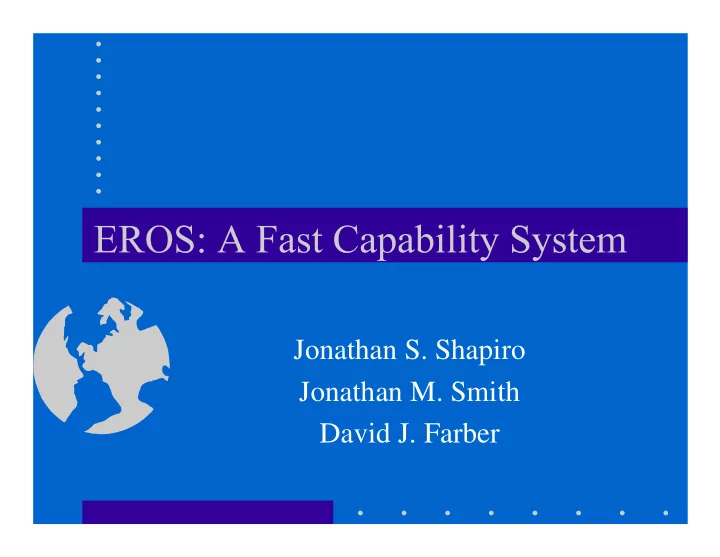

Jonathan S. Shapiro Jonathan M. Smith David J. Farber
• Priorities 1.Security & Integrity 2.High availability 3.Fault Tolerance 4.Evolvability 5.Performance • This ordering has architectural and performance implications.
• Pure capability system • Transparently persistent • Recovers rapidly (< 30 seconds) • Thoroughly paranoid implementation – Consistency checks to prevent snapshot of bad states – Implementation tries to be “fail fast” – Think: kernel always compiled for debugging • Some emphasis on discretionary security
• A capability is an (object, (myspace, {r, w}) permissions) pair – Unforgeable, so a basis for protection – Transferable, so a basis for authorization • This can be generalized to (spaceroot, rw-space) (object, type) (spaceroot, node) • An object version number makes reallocation simple. 32 bits type misc bits • The resulting representation is version 4 words straightforward. object identifier
Comparison to Other Capability Systems System HW/SW Store Persist Cap Prot Mem IPC Model Cal TSS SW File Explicit Partition Byte Buffered, Segments Unbounded CAP HW Object Explicit Partition Byte Prot. Segments Procedure Call Hydra Mixed File Explicit Partition Byte Prot. Segments Procedure Call S/38 HW + Object Transparent Tagging Byte Prot. (AS/400) Compiler Segments Procedure Call i432 HW Object Explicit Partition Byte Prot. Segments Procedure Call Mach SW App. Explicit Partition Page Buffered, Defined Regions Unbounded Amoeba SW Object Explicit Sparsity Page Buffered, Regions Bounded SW Object Transparent Partition Pages + Unbuffered, KeyKOS/ Nodes Bounded EROS
Node Page Capability PTE Page Table Entry: Phys Page Number {w,s,v} Object identifier Type Capability 32 bits type misc bits version 4 words object identifier Page
• Processes have user-mode p 0 p 1 p 2 p 3 p 4 p 5 ... p n machine state plus supervisor- implemented capability registers. • Kernel implements a machine- specific process table – Used to cache active processes (c.f. Cache Kernel, Fluke). – Fast-path IPC uses this structure. – General capability invocation path uses both representations. • Process state is recorded in nodes.
• Everything (all resources) is named by a uniform naming mechanism: capabilities. • The protection state of the system can be directly realized by the hardware. • All user-visible state is stored in pages and nodes – This plus “run list” is all you need to define a recoverable system state. • Object reference is a protected operation – Conventional operating system services can therefore be implemented outside the kernel.
Process Mapping Table Structures Checkpoint, Page Faults Invocation Ageing Node, Page Cache (Main Memory) Node, Page Cache (Main Memory) Checkpoint, Object Object Migration Ageing Faults Faults Write-ahead Permanent Store Checkpoint Log
• How might a system be structured on top of this kind of platform? • How does it perform? • Given that it is unconventional, why should you care? • Where do we go from here?
Fault Handler Space Bank Program Prime Space Bank Address Space Other Space Banks Other Services
• Memory fault handlers • Storage allocator (space bank) • Files and Directories • Pipes • Constructor (confinement implementation) • Reference monitor
• Initial Conditions: – Client has exclusive access to service. – Confined entity has no unauthorized channels. • Confined entity can be a complex subsystem. • Client therefore completely controls communication.
Reference Monitor w/Confinement Confined Compartment Sandbox Process Reference Monitor Kernel • Reference monitor knows object semantics. • Interposes transparent forwarding objects where appropriate. • Can be evolved as new object types are introduced.
Reference Monitors Confined Compartment Sandbox Process Reference Reference Monitor Monitor Kernel • Multiple reference monitors can securely manage disjoint logical systems on the same hardware. • Remote Hot Standby
1.6 Triv. Syscall (us) 0.7 0.367 Pg Fault (us/10) 6.7 (2.0.34 kernel) 2.042 Grow Heap (us/10) 3.174 EROS 1.19 Ctxt Switch (us) 1.26 Linux 2.2.5 0.664 Create Process (ms) 1.92 3.56 400 MHz P-II Pipe BW (s/GB) 3.85 512 Kbyte cache 5.66 Pipe Lat (us) 8.34 192 MBytes 0 2 4 6 8 10 Note: 2.2.x kernel introduced a temporary performance bug in page fault handling.
Property L4 EROS Issue Registers Most All Covert Channel saved Payload 31 x 4M 1 x 64k Resource Exhaustion, Target name Thread ID Capability Encapsulation Authority Permissions for Capabilities Access Control, Xfer Pages Channel audits Atomicity No: Preemption, Yes Bounding Page Faults resources and time Missing Timeout, then Discard Covert Channel page strategy discard
Property L4 EROS Issue Registers Most All Covert Channel saved Payload 31 x 4M 1 x 64k Resource Exhaustion, Target name Thread ID Capability Encapsulation Authority Permissions for Capabilities Access Control, Xfer Pages Channel audits Atomicity No: Preemption, Yes Bounding Page Faults resources and time Missing Timeout, then Discard Covert Channel page strategy discard 454 cycles 640 cycles Latency Large spaces
• It appears possible to build a high-performance capability system. • Persistence greatly simplifies some components, and therefore assurance. • Capabilities provide a sufficient primitive protection mechanism to implement other security policies at user level. • Using performance as the only evaluation criterion can obscure important issues, including security.
• How can a capability system be distributed securely and efficiently? • How is multiparty administration and just-in-time software provisioning to be managed? • How can assurance be achieved using an open development model? • Compatibility and (r)evolution • System structure – design and architecture • Language integration: how to do it successfully
• IBM Research has started the Cougar project to investigate secure, high-performance underpinnings for pervasive devices and their supporting servers. • Cougar will be capability based, and will borrow from both the L4 and the EROS architectures.
Recommend
More recommend